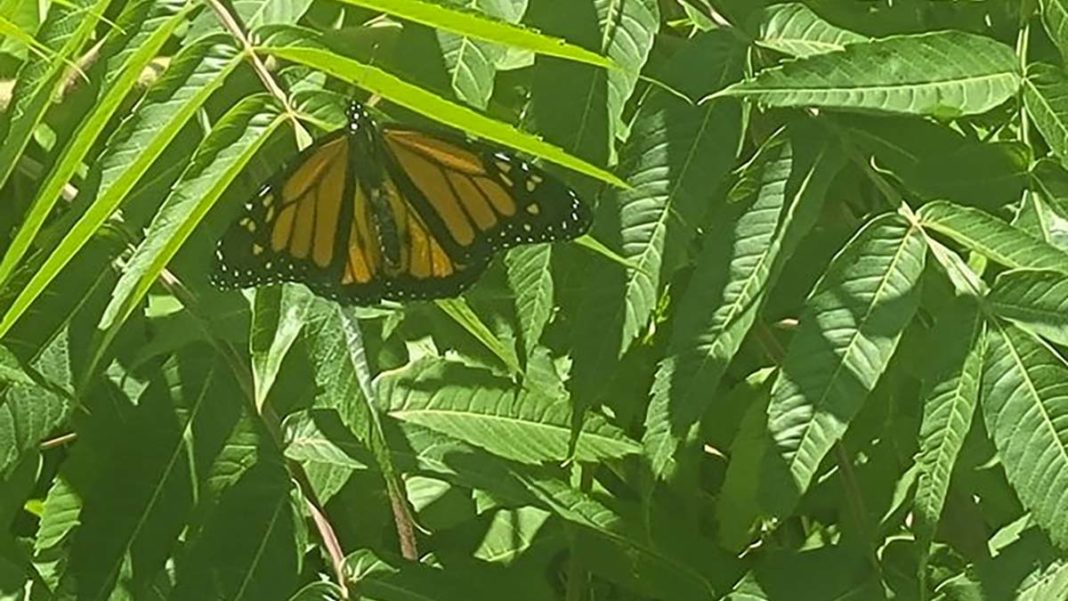WIIKWEMKOONG—While the beloved monarch butterfly has now been put on the endangered species list by International Union for Conservation of Nature (IUCN) scientists, local species-at- risk representatives say the butterflies are not in as dire straits on Manitoulin Island. The environment in the US and in the southern part of Ontario has had more of a negative impact on the species.
“We do have them here in the community (Wiikwemkoong Unceded Territory), and if you drive around, you will come across monarchs here and around the Island,” said Theodore Flamand, species-at-risk coordinator for Wiikwemkoong. “I don’t think they are in dire straits here. And with more public education, we can help the monarch populations in the right direction.”
“It is definitely not a ‘me’ project, but a ‘we’ project, everyone needs to get involved in protecting and helping the monarchs,” said Mr. Flamand. He pointed out milkweed and the planting of it, is critical to the survival (of monarchs) as the plant is needed for monarchs to reproduce. “Usually, they can be found in areas like ditches and it is important not to cut them down. When we bring kids out here on field trips, we explain that they are important.”
Judith Jones, a project biologist with the Wiikwemkoong Species-at-Risk program told The Expositor, “The threat to monarchs that travel to Mexico is mostly not in our area, but in southern Ontario and areas of the US. She explained the main issue relating to the monarch populations decrease took place in the period from 1999-2015 when the crop area for farmers increased, and with it an uptake in herbicides used on soy and canola crops. “That caused about an 80 percent decline in the monarch population.”
The Wiikwemkoong Unceded Territory has a species-at-risk website that includes the monarch. “We are doing our part to provide as much public education on monarchs as possible,” said Mr. Flamand. “I do presentations around Ontario, and I explain everything bonds together. There is a chain reaction when one plant or insect species is removed it causes a chain reaction.”
The endangered species list for IUCN, or red list, is an indicator of the health of the world’s biodiversity. Monarchs are not yet listed on the US Fish and Wildlife Services federal endangered species list. Six years ago, they were designated as an endangered insect by the committee on the Status of Endangered Wildlife in Canada.
Scientists put the iconic orange-and-back insect on the endangered list this month because of its fast dwindling numbers. The IUCN added the migrating monarch butterfly for the first time to its red list of threatened species and categorized it as endangered. The group estimates that the population in North America has declined between 22-72 percent over 10 years, depending on the measurement method. The population of monarchs in the eastern US has estimated to have declined between 85-95 percent since the 1990s.
In North America, millions of monarch butterflies undertake the longest migration of any insect species known to science. After wintering in the mountains of central Mexico, the butterflies migrate to the north, breeding multiple generations along the way for thousands of miles. The offspring that reach southern Canada then begin the trip back to Mexico at the end of summer.
A smaller group spends winters in coastal California, then disperses in spring and summer across several states west of the Rocky Mountains. This population has seen an even more precipitous decline than the eastern monarch, although there was a small bounce back last winter, the IUCN reports.
Ms. Jones said “We are planning our migration count, called the trans-Manitoulin monarch butterfly count, either the third or last week in August or early September on Manitoulin.”





